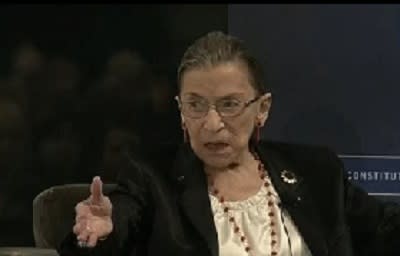Justice Ruth Bader Ginsburg talks about judicial activism
Supreme Court Justice Ruth Bader Ginsburg told a National Constitution Center audience why she is speaking out about “judicial activism” in recent Supreme Court cases involving voting rights and health care.
Justice Ginsburg was interviewed by Jeffrey Rosen, the Center’s chief executive officer, for about 90 minutes before a sold-out audience in Philadelphia on Friday night.
The Justice, who wrote a spirited dissent in the Shelby v. Holder case about voting rights, spoke in depth about her recent public statements about the Court’s conservatives as being activists by using the court system to overrule laws.
In a recent New York Times interview, Ginsburg issued a definition of activism: “if it’s measured in terms of readiness to overturn legislation, this is one of the most activist courts in history.”
At the National Constitution Center, Justice Ginsburg explained in detail two examples of what she sees as activism.
“It is a court that is not at all hesitant to overturn legislation passed by the Congress … take two very recent headline examples,” she said.
“The Affordable Health Care Act passed Congress, but the Court held that the Commerce Clause didn’t go that far, but thank goodness there was a taxing power that saved the case,” she said.
“But the readiness to strike down a piece of legislation under the Commerce Clause … it was astounding to me.”
Justice Ginsburg also spoke about the recent decision in the Voting Rights Act case, in which a 5-4 majority sent parts of the law back to Congress to be rewritten.
“The worst case was the Voting Rights Act case. That passed Congress overwhelmingly and I think it was unanimous in the Senate … if anyone knows about Voting Rights, how it affects the system, I think the elected representatives, have an appreciation of that, that the unelected judges don’t have. Yet despite the overwhelming majority in Congress that passed the Voting Rights Act , the court said, ‘that won’t do’,” she said.
“That is an example of striking down legislation on a subject that the people in the political arena are better informed about than the Court is.”
Justice Ginsburg said her model as a lead dissenter on the Court was John Paul Stevens.
“I was heir to that role as the most senior justice on the dissent side,” she said.
One of the memorable lines of her dissent in Shelby was, ““It is like throwing away your umbrella in a rainstorm because you are not getting wet.”
“But the storm is raging,” Justice Ginsburg said about voter ID laws that were quickly implemented in states like Texas after the Shelby decision.
“I expected that to happen,” she said. “Now it’s a problem what to do, [with] closing the polls early, putting them in inconvenient places,” she said.
Note: You can watch the full 90-minute interview with Justice Ginsburg in video from C-SPAN below. We will also have edited video highlights on this blog throughout the week.
Recent Constitution Daily Stories
Is this President Obama’s “Eisenhower moment”?
Scorecard: Where 16 public figures stand on the Syria debate
Update: Obama to address nation about Syria situation
Vote Now: An amendment to ban desecration of the American flag


